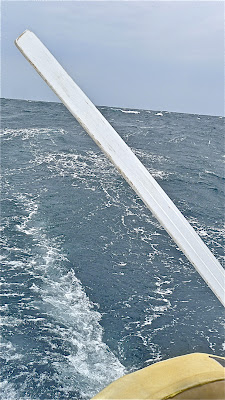 We stepped out into the wider Pacific last week. All the way to Ecuador from the Perlas islands in Panama the wind not only blew moderately but stayed behind us, and the seas did too. The moving sidewalk of current beneath us was pretty much in our favor as well. At times the speed log was showing above nine knots. A person could get spoiled moving as expeditiously as this!
We stepped out into the wider Pacific last week. All the way to Ecuador from the Perlas islands in Panama the wind not only blew moderately but stayed behind us, and the seas did too. The moving sidewalk of current beneath us was pretty much in our favor as well. At times the speed log was showing above nine knots. A person could get spoiled moving as expeditiously as this!
On the motor! And break out the Bailey’s Liqueur – the equator demands an obligatory tot for King Neptune and one for the crew! Make that two! Then I went back to bed to freshen up for my date in the cockpit at 1 AM.
The fleet of about 15 boats bound west and south for the Galapagos was also having generally good conditions and favorable winds, despite the occasional spinnaker wrap or hole with no wind in it. I am as always impressed by the way people in this community help each other along, and especially by the family boats who have children as well as boats to manage, the parents like nautical Ginger Rogers, doing it in in high heels, and backwards! I’ll miss the radio reports from people we’ve met, and from those we’ve never seen, as they move through the Galapagos and into French Polynesia while we head for the Andes.
This, apparently, is the light. So, did they not see us until we passed, or were they looking for the matches?
To enter the Rio Chone from the Bahia de Caraquez, we need a high tide, and a pilot. So we had to do some dawdling and anchoring to wait for the tide at 5:58 PM on the Saturday before Easter. The tide was 9 1/2 feet that night, and the least water I saw on the sounder as we went in was 9.1 feet. I gather, however, that the currents and tidal rips can be a larger issue than the water level. The pilot, Pedro, stood behind Doug at the helm and waved his hand around, faster, slower, left, right. There is an old light tower standing in the shoreline shoals, offering no information that wasn’t already obvious; no other marks, no ranges, and not much margin for error. I was happy to pay the pilot’s $30 fee.
Then Pedro helped us tie up, fore and aft, to buoys in the small mooring field that will be our home for the next while. Anchor-up to mooring ball cleated off, we were snuggly settled in in less than 4 1/2 half days, after roughly 555 miles. So much for the bald-arrow weather forecasts.
A health inspector arrived to look us over. He looked over our groceries too, not to confiscate but wanting a list of items to pad out his form (leche, huevos, carne, banana) , then wrote it out again by hand as our receipt, and skedaddled away for Saturday night elsewhere. I had been just about to ask him: “Does anyone ever say ‘Yes, I am carrying psychotic drugs, lots of them'”?
Our passports and copies of our documents went ashore; we would pay various fees later, but we would also get everything back on Tuesday morning and in the meantime we were free to enjoy ourselves ashore: a shower and dinner out were what the health officer recommended. Welcome to Ecuador!
Maybe you can zoom in to see us in the Rio Chone close to the bridge at the top left.

Marlins, heu? We caught a 100lb sailfish off of San Jose (Perlas) last week… wished you were here to taste the smoked fish!!!! Miss you, guys!